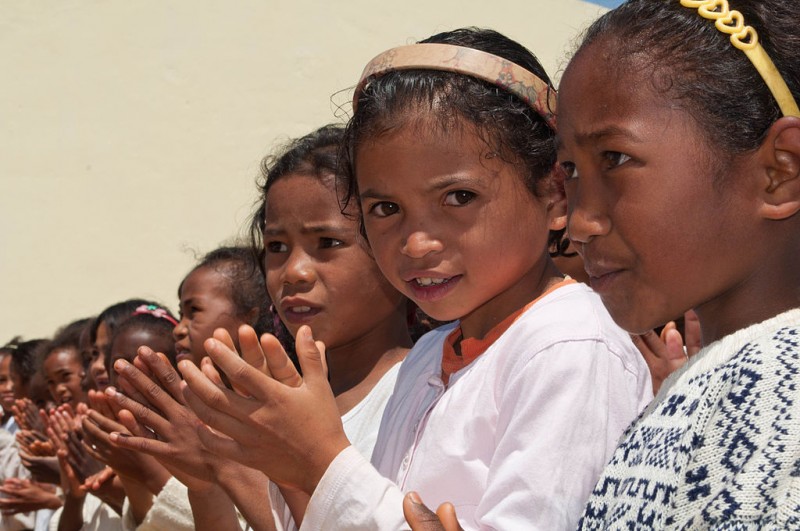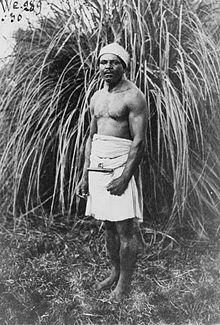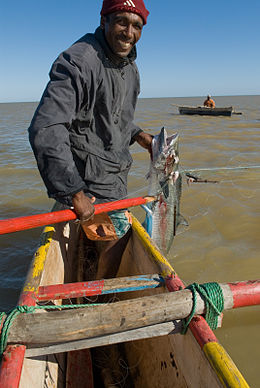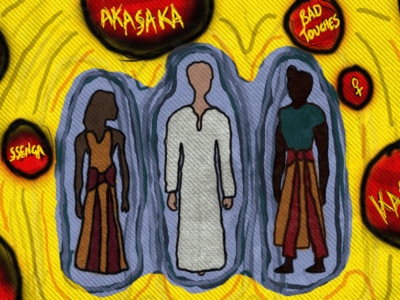Madagascar is the world's fourth largest island by area, yet it still remains a mystery to many people. Recently in the spotlight because of a visit from Valérie Trierweiler, former partner of French president François Hollande and author of the bestseller “Merci pour ce moment” (Thank you for the moment), Madagascar is as intriguing for its biodiversity as it is for the way it straddles Asia and Africa.
So, whether you are planning your first trip to Madagascar, you want to know about your friends’ homeland, or you just want to learn more about this part of the world, here are eight things you might have been wondering about Madagascar but were afraid to ask. The answers come from Malagasy citizens who are active on the web—check out their blogs and videos.
1) I'm going to Madagascar soon and would like to get a better idea of what everyday life is like for the people there. What is the typical way of life for the Malagasy?
That depends who you ask. According to the World Bank, 90 percent of the Malagasy people live on less than US$2 per day. The disparities of wealth in Madagascar are such that there is not really a typical way of life to speak of. Randriamihaly,a blogger in Madagascar, describes the disparity:
Ainsi, les princes et les princesses sont ceux qui possèdent le plus. Il ne faut pas s’étonner de les entendre parler de leur vie à Tana comme d’un conte de fées. Ils vivent dans une bulle increvable. Leurs palaces gardés par les agences de sécurités sont truffés de meubles dorés et de gadgets de haute technologie. Ils sortent de là en 4×4 pour aller dans ces lieux qui leur sont réservés : écoles américaines ou françaises, restaurants, piscines, spa, centres commerciaux. [..] A quelques mètres de là, dans Antananarivo, l’enfer, c’est ce que vit la famille d’Ernestine. Cette femme se lève très tôt le matin afin de préparer ses enfants pour l’école : se laver à l’eau froide du bidon, manger la soupe de riz avec le bout de viande fumée et partir à pied. L’école, c’est le rêve auquel elle s’accroche. Elle croit que si ses enfants parviennent à décrocher un diplôme, n’importe lequel, ils pourront s’en sortir plus tard et ils n’auront pas à vivre un calvaire quotidien comme elle. Elle va chez les patrons, elle peut tout faire : lessive, vaisselle, ménage, porteuse d’eau, garde d’enfant, tout. Et le soir, elle revient exténuée, ses enfants dorment déjà. Elle veille sur leur sommeil à cause des rats qui peuvent attaquer. Et puis, comment avoir un bon sommeil lorsqu’on est à 4, 5 ou 6 à dormir dans une seule pièce de 2 m de largeur ?
The princes and princesses are the ones who have the most. Don't be surprised if their lives in Tana sound like fairy tales. They live in an impenetrable bubble. Their luxury hotels are protected by security guards, filled with gilded furniture and high-tech gadgets. They go out in their 4x4s to places only they go: American or French schools, restaurants, pools, spas, shopping centers. . . . A few meters away, in Antananarivo, Ernestine's family is living in hell. She gets up very early in the morning to get her children ready for school: washing up with cold water from a can and eating rice soup with a bit of smoked meat before leaving on foot. She clings to the dream of a good education. She believes that if her children manage to get a diploma, any diploma, they will later be able to get by and won't have to suffer everyday like she does. She goes to her employers’ homes and does everything for them: the laundry, the dishes, the cleaning, carrying water, babysitting, everything. And in the evening, she comes home exhausted, her children already asleep. She stays up while they sleep to watch out for the rats that can attack in the night. Besides, how can anyone have a good sleep when there are four, five, even six people sleeping in a single two-meter-wide room?
So there is no such thing as a typical everyday life in Madagascar; this is true in any country but especially this one, a country where the middle class is just a sliver.
2) How do you pronounce the current president's name?
Hery Martial Rajaonarimampianina Rakotoarimanana has been the president of Madagascar since January 2014. According to The Guardian, his name is the longest of any current world leader. It's not easy to pronounce, even for the Malagasy. If you ever meet the president, instead of taking the risk of butchering his name and bringing diplomatic embarrassment upon yourself, it might be a better idea to refer to the name of his party, the Hery Vaovao (“New Forces”), or lend him a flashlight to keep him from worrying about electric power all the time. But if you really insist on pronouncing his name, here is how you should say it ( at 0:09 in the video) :
3) We're planning on cross-country hiking across the island. What do we need to know to stay safe?
News out of Madagascar these past few years has been full of stories of poverty, health crises, instability and highway robbery. The memories of two vazaha (white foreigners) being lynched on the Madagascan island of Nosy Be are still fresh in people's minds. That being said, hiking across the island is a unique experience that many tourists and Malagasy embark on every year.
The main health risk is malaria. The country as a whole is classified as being in Zone 3, meaning that the strain of malaria found here is somewhat resistant to chloroquine (the most frequently used anti-malaria medication worldwide for both prevention and treatment). Malaria is present over 90 percent of the Madagascar territory. Here are some tips to stay protected: (via Le Guide du Routard, a renown tourist guide for french-speaking backpackers):
- il est indispensable de prendre un traitement antipaludique.
– le soir, porter des vêtements les plus couvrants possible et, mieux encore, traités (par exemple avec Insect Ecran® trempage) ;- sur les parties découvertes, utiliser lotions ou crèmes répulsives efficaces. S'enduire les parties découvertes du corps dès le coucher du soleil ;
– utiliser une moustiquaire.
- Antimalarial medication is a must.
– In the evening, wear clothes that cover you as much as possible. If the clothes are medicated (for example, with an antimalarial fabric soak such as Insect Ecran®), even better. Slather an effective mosquito repellent lotion or cream on exposed body parts, especially after sunset.
– Use a mosquito net.
Chikungunya and other tropical diseases are also found in Madagascar. The basic rules for avoiding them are the same as in any other country. As far as instability is concerned, there are no official statistics on crime in Madagascar, but it is present enough in public consciousness to have a negative impact on tourism . Mofo Lany, who lives in the country's capital of Antananarivo, offers his point of view:
Il ne se passe pas une semaine sans que les journaux ne relatent des faits de violences dans la capitale malgache Antananarivo. Toutes les couches de la population, des plus aisées aux plus modestes, sont victimes de ce phénomène. Même les étrangers ne sont pas en reste. Les attaques à main armée sont particulièrement nombreuses.
Not a week goes by without the newspapers reporting violence out of Antananarivo, Madagascar's capital. All levels of society, from the most well off to the least, are victims of this phenomenon. Even foreigners are not immune. Holdups are particularly common.
4) Should I learn Malagasy when I am in Madagascar? If so, how?
Ideally, yes. But like learning any language, Malagasy requires determination and high motivation. And, like any other language, it has its easy aspects and not-so-easy aspects. The pros:
- No distinction between gender such as masculine or feminine
- No distinction between number: singular and plural are the same
- Only three tenses: past, present, future, and unconjugated
As for the cons, Lilikely, a French expatriate, shares the experience of learning Malagasy as a vazaha (“foreigner” in Malagasy):
- Déjà, pas mal de gens parlent un peu français : beaucoup dans les grandes villes, et assez peu dans les campagnes. Du coup, c'est plus facile pour se faire comprendre, on finit toujours par trouver quelqu'un pour nous aider si ce qu'on cherche est compliqué. Du coup, on n'a pas besoin de se forcer, et si on est un peu flemmard, on profite de cela.
-La grammaire. Ca parait simplissime au début. MAIS… Tout cela c'est pour la forme active. Et au final, les malgaches s'expriment surtout avec la forme passive… nettement plus difficile à maîtriser.
– Les références culturelles et la façon d'exprimer les idées sont aussi très éloignées des nôtres
– Les spécificités régionales font que le découragement arrive vite lorsqu'on voyage.
- Quite a few people speak a bit of French: a lot in the bigger cities, less so in the countryside. So that means it's easier for people to understand you, and someone can always help you if you have trouble finding what you need. So you don't need to try that hard, and if you're kind of lazy, that's okay.
-The grammar. It seems simple at first. BUT… That's only for the active form. And, it turns out, the Malagasy mostly speak using the passive form… which is obviously harder to master.
– The cultural references and the way people express their ideas here are also very different from our own.
– Linguistic features that are specific to particular regions can be easily discouraging when you're traveling.
How can a person learn Malagasy? Here are some resources that can give English speakers an introduction to the language: the basics on mylanguages.org, a phrasebook from Wikitravel, and an explanation of the verb tenses.
5) Are the Malagasy people African, Asian, or something else?
Ah, the question that won't go away! This is the part where we tackle the more controversial questions about Madagascar. This particular question is understandable as the country is situated right between Africa and Asia and its population is very diverse. The problem is the debate that comes after the question–discussion on the subject is often steeped in prejudiced, racist undertones. If you are truly curious and can read French, Dominique Ranaivoson, a professor and expert in Malagasy literature, has written at length on the topic in French. One of the first facts to know is that 18 traditional tribes have been counted in Madagascar, which include people of African, Asian, or Arab origin. Another fact is that a sort of latent racism exists between these different Malagasy groups.
6) Why do some Malagasy people “turn the bones” (famadihana) of their dead relatives?
Ah, the other controversial question! The famadihana, or “turning of the bones,” is a funerary tradition honoring ancestors. An explanation of the ritual from Lay in Antananrivo:
Un razana (ancêtre) peut se manifester à un de ses descendants dans son rêve ou dans un tromba en lui disant qu’il a froid. Il promet en contrepartie de bénir ses descendants dans leur vie quotidienne. C’est ainsi que les Malgaches rouvrent les tombeaux et remplacent les tissus qui recouvrent les restes de leurs morts. C’est l’occasion de fêtes monumentales, de danses et de beuveries
A razana (ancestor) might appear to one of his or her descendants in a dream or in a vision, complaining of cold and promising to impart blessings upon the lives of his or her relatives. This is why the Malgasy reopen their family members’ tombs and replace the shrouds covering the remains of the dead. It is a time of massive celebration, dancing and drinking.
Soahary explains the particular way the tradition fits in the context of Malagasy culture:
La relation des Malgaches avec la mort et les parents déjà partis est assez particulière. On considère que nos ancêtres veillent sur nous. Ainsi, ils ne sont jamais vraiment partis. On leur rend hommage périodiquement en recouvrant leur corps de nouveaux linceuls.
The Malagasy people's relationship with death and deceased family is rather unique. We consider our ancestors to be watching over us, and thus, they are never really gone. We pay tribute to them periodically by wrapping their bodies in new shrouds.
Hemerson Andrianetrazafy, lecturer and researcher in civilization at the University of Antananarivo, adds:
Le famadihana est très exactement le rituel par lequel la dépouille d’un parent atteint le statut de razana, d’ancêtre. Un moment capital dans la spiritualité malgache, car tous les morts ne deviennent pas automatiquement des razana [..] Pour les Malgaches, la mort n’est pas une dissolution, un anéantissement, mais une étape conduisant au statut d’ancêtre. « Tsy maty fa lasan-ko razana », (Ils vivent mais sous une autre forme), servant d’intermédiaire entre les vivants et les zanahary, les divinités.
In fact, famadihana is the ritual that makes a family member's body achieve razana (ancestor) status. It is a major event in Malagasy spirituality, for not all of the dead automatically become razana. . . . Tsy maty fa lasan-ko razana (They live on, but in another form), serving as mediators between the living and the zanahary, the deities.
Many Christian Malagasy people have pointed out this practice is in conflict with Biblical principles. The practice of famadihana is becoming less common for this reason, as well as the high cost of the ceremony.
7) Why is circumcision (or hasoavana in Malagasy) so common in Madagascar?
Another tradition in Madagascar is the circumcision of young boys before the age of two.
This is another opportunity to celebrate as a family. In Madagascar the practice is not linked to any religious tradition, but it is not without controversy. Ariniaina explains why she had her son circumcised:
Mais pourquoi faire ce rituel? J’allais me justifier en disant que c’est pour des raisons médicales. Comme quoi des saletés peuvent rester dans le prépuce, que plus tard, il se peut qu’on doit quand même le circoncire parce qu’il aura des problèmes de santé. Il sera alors plus âgé, plus conscient de la douleur. Ainsi, j’aurai regretté de ne pas avoir fait la circoncision plus tôt. Mais, au fond, est-ce la culture qui l’emporte? N’est considéré « vrai homme » que celui qui est circoncis.
But why partake in this ritual? I was going to justify it by saying that it's for medical reasons. That dirt can get trapped in the foreskin, meaning he may have to later be circumcised anyway due to the resulting health problems. And by then he'll be older and more aware of the pain, and I would regret not getting the circumcision done sooner. But the truth is, it is cultural: he who is not circumcised is not considered a “real man.”
8) What is the connection between Madagascar, the country, and “Madagascar”, the cartoon?
There isn't any. Well, two things, actually: 1) Nightclubs in Madagascar really did groove to “I Like to Move It, Move It” in the 1990s. 2) Jeffrey Katzenberg, CEO of Dreamworks, the company that produced the “Madagascar” film trilogy, has donated US$500 000to the non-profit organization Conservation International to promote ecotourism in Madagascar.










5 comments
Every one of us guarantee well-timed offer. If you place a superb receive while using the web page as well as symbolize your current deadline day, folks won’t possess even to take into account the exact cardstock. Just click look into down below.
The last question of what is the connection between Madagascar country and the cartoon i think it’s wrong answer of what you replied because the former president of Madagascar Marc Ravalomanana wanted to promote ecotourism in Madagacar and made a collaboration with a film maker to promote Madagascar country abroad so which means of course there is obviously a relation between this two. Even i remembered he asked a meeting for all of his ministries to watch the cartoon together. LOL.